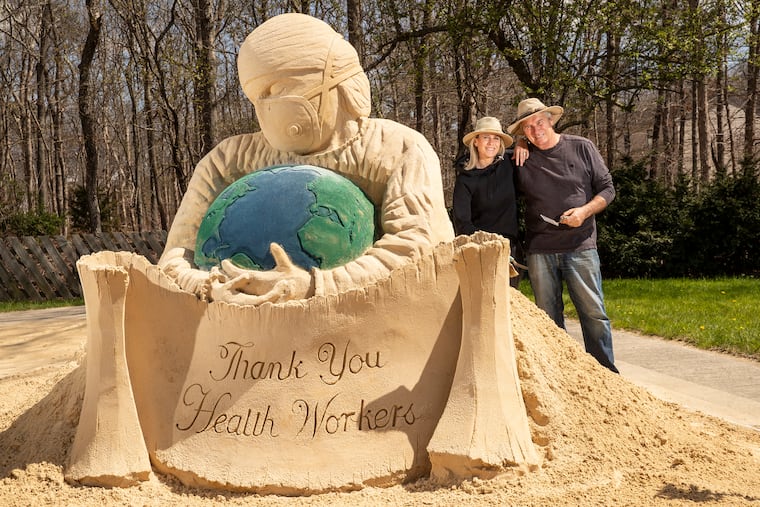A South Jersey couple created a massive sand sculpture to thank health-care workers on the front lines of the coronavirus pandemic
The six-ton sand sculpture depicts a woman with a surgical mask and a tear in her eye holding the world in her hands and the message "thank you health workers."

From her South Jersey home, Laura Cimador-Gowdy watched in fear as the coronavirus ravaged her native Italy. Her relatives relayed grim messages about sick friends. Then, the pandemic hit the United States.
Through it all, she could not stop thinking about the courage of health-care workers, who often sit with coronavirus patients as they die, in lieu of family members who are forced to stay away.
Patients “die in the arms of the health-care workers. They are our angels," she said. “There is no thank-you big enough for these people.”
She and her husband, John Gowdy, have done their best to capture their gratitude.
During their time in isolation, they’ve created a six-ton sand sculpture that bears the message “Thank you health workers." A woman with a surgical mask is depicted, she has a tear in her eye and holds the world in her hands.
The massive tribute sits in the couple’s backyard in Galloway, and has only been seen in person by the Gowdy family and an occasional intrigued passerby. But images of the sculpture have been viewed and shared hundreds of thousands of times on social media.
The couple said they have been “overwhelmed” by messages from health-care workers, ordinary people, and grieving families, who tell them they, too, are at a loss for the right words to express their thanks to doctors and nurses who were there in their loved ones’ final moments.
“There is nothing bigger that a human being can do for another human being,” Cimador-Gowdy said.
For her and her husband, both artists, a sculpture was the natural way to pay tribute.
John Gowdy, a 62-year-old retired Atlantic City Fire Department captain, is a professional sand carver. More than three decades ago, he started making sand castles with shells and Popsicle sticks on Jersey Shore beaches, mostly to entertain his three young children.
Other beach-goers ogled at the family’s creations, and they began competing in local sand contests as a team, calling themselves “the Rowdy Gowdys." Since then, Gowdy has gone on to win national and international sand-sculpting competitions.
Cimador-Gowdy, a 51-year-old former schoolteacher, does oil painting, and met her husband when he was competing in sand-sculpting on an Italian beach near her childhood home. The couple lived in Italy for more than a decade before returning last year to the Atlantic City area, where Gowdy grew up.
Their most recent creation began with a sketch of a health-care worker holding the outline of Italy, which was for a time the European epicenter of the pandemic. Cimador-Gowdy was born in a town in northern Italy, the country’s hardest-hit area.
Last month, as she heard frightening reports from her family, she and her husband turned that sketch into a sculpture. In their backyard, they have an in-ground pool full of sand — which Gowdy calls his giant personal “sand box” — from which they built the piece. The first iteration read: ”Forza Italia. Italy Strong.”
As the pandemic spread to the United States, and New Jersey saw death tolls rise, the couple agreed they should update the sculpture. Last week, they placed the finishing touches on the global tribute. Cimador-Gowdy’s 19-year-old son, Ludovico Menegon, created a time-lapse video of the entire process, showing the sculpture’s evolution.
The sand creation cannot be moved, Gowdy said. But when the pandemic relents, he wants to re-create the image in marble and display it somewhere. Perhaps outside a hospital, he said, to remind everyone not to forget “the people who hopefully rescue us.”